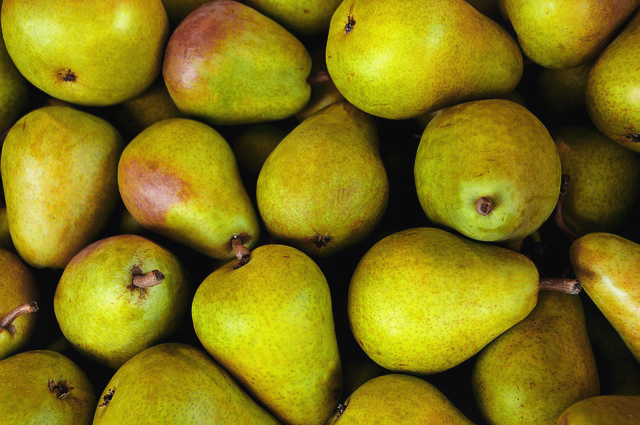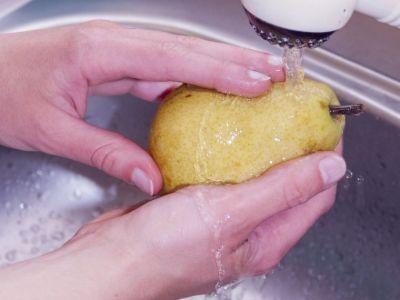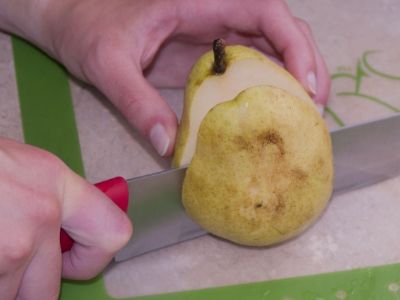Pears

Preparation: Step-by-Step

Wash hands. Thoroughly rinse pears to remove dirt. Peel if desired.

Cut pear lengthwise in half with a sharp, clean knife. Remove core with a paring knife or melon baller.

Hold pear and cut into quarters. Place pear cut side down. Slice to desired thickness.

Stack slices and cut into strips. Make perpendicular cuts to dice. To prevent browning, brush or dip with solution of half lemon juice and half water.
Grow.
- Select disease-resistant root stock; especially resistant to Fire Blight. Pears require
cross-pollination from another variety to produce a large crop. For standard trees,
allow 20-25 feet in all directions from buildings or other trees. Allow 12-15 feet
for semi-dwarf trees and 8-10 feet for dwarf types. For best pollination, plant pear
trees within 100 feet of each other. Plant in full sun in early spring. Set plant
in soil at the same depth as it was in the container and replace soil firmly against
roots. In a one-foot diameter around the trunk, water and apply fertilizer as recommended.
Visit msuextension.org for more information or contact your local MSU Extension office.
Harvest.
- Do not let pears ripen on the tree. The result will be gritty and non-palatable fruit. Harvest when the skin color turns from dark green to a lighter yellow-green color. The lenticels (dots) often will change from white to brown and the skin of the fruit will become smooth and waxy. To avoid damaging the fruit buds for the next year’s crop, carefully twist or cut fruit from the stems; do not pull them off.
- Chose firm pears. Check the neck for ripeness daily by applying gentle pressure to the stem end of the pear with your thumb. If it gives to gentle pressure, it is ripe.
- Store fresh pears in the refrigerator for up to three weeks. Store unripe pears in a paper bag at room temperature.
- Most fruits are rich in fiber and phytochemicals, but provide negligible amounts of saturated fat, trans fat, cholesterol, and sodium and are gluten-free. Pears have only 40 calories per half-cup serving and their skin is rich in Vitamin C.
Bake.
- Add diced pears to muffins, cakes, crisps, oatmeal, pies and breads for additional flavor and moisture.
Poach.
- Heat four cups water and 1 and 1/3 cups sugar until sugar is dissolved. Once sugar is dissolved, add peeled, quartered, and cored pears and desired seasonings. Allow pears to simmer for 15 to 20 minutes until tender.
Raw.
- Wash and eat whole or sliced. Enjoy with low-fat cottage cheese for added protein. Add dried pears to oatmeal or cold cereal.
Salsa or Salad.
- Peel and dice pears for a refreshing summer salsa or add to any green salad.
Season.
- To enhance the flavor of pears, use cloves, cinnamon, ginger or vanilla beans.
Preserve.
- For information on preserving fruits, look for the MSU Extension MontGuides: Freezing Fruit; Drying Fruit; Processing Fruit and Tomato Products in a Pressure Canner; Making Jams, Jellies, and Syrups. Visit msuextension.org for more information or call your MSU Extension office.
For More Information:
Montana State University Extension: msuextension.org
MSU Extension Master Gardener: mtmastergardener.org
MSU Extension Food and Nutrition: nutrition.msuextension.org
MSU Extension Nutrition Education Programs: buyeatlivebetter.org
Date of Publication: January 2014
